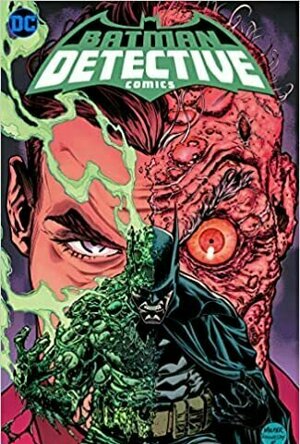Joe Goodhart (27 KP) rated Batman: Detective Comics, Volume 5: A Lonely Place of Living in Books
Nov 30, 2020
The ride thus far has been quite good! Tynion's treatment of Batman gives us a more faceted aspect of the Dark Knight. Yes, there is still the "Dark" to his "Knight", but there is also a bit of humanity, like the way he is in regard to Tim Drake, as well as Stephanie Brown/Spoiler. It reminds of what I liked most about the character as I was growing up in the 80s and 90s, something that appears to have been forgotten as Tom King continues to present a Batman that really was not needed! I look forward to him taking over from King on the BATMAN main book!
Spoiler, unfortunately, was still kinda mopey and angst-y in this volume as well. I dunno. When she came on board as the fourth Robin and then became the fourth Batgirl, I passed on it. It really did not have any attraction for me. However, in the first three volumes of "Rebirth" DETECTIVE COMICS, before Tim was grabbed by Mr. Oz (or was it Dr. Oz? lol), she was quite likeable, even kinda fun. After the whole "Tim Incident", the suck-itude was strong and hard! Hopefully, she will be more herself in Tynion's final volume of 'TEC!
The story was quite good, as it dealt with Tim Drake, and his role in the DCU since Dr. Manhattan made those missing 10 years go bye-bye. At points, it felt very much like a hackneyed plot element, but it still was not that bad. Not great, mind you, unlike the previous volumes, but not the worse treatment (that goes to King) of the Batman fam!
The other element that left this off my "Favorites" shelf, as well as only as high as 3 Stars, was the art from Eddy Barrows. He had some really great backgrounds and figure shots, but his faces? Um, no. Several times it looked like Tim was grinning when he should not have. Also, there were some other "that's not right" facial moments for much of the other supporting characters. I think he is a good artist, but I think whoever was editing that run should have been more aware of that!
Now, Alvaro Martinez? Perfect! His style was perfectly suited to Gotham City and the world of Batman. I would have loved him for the whole volume instead of the little bit he had. Hmm.. Maybe Tynion IV can bring him along for his upcoming run on BATMAN? #hopeful
So, yeah, I <i>liked</i> "A Lonely Of Living", but I didn't <i>love</i> it, dig? There was some good stuff, but overall, I would likely not want to re-visit it at a later date. Ah well, on to FALL OF THE BATMEN..
Joe Goodhart (27 KP) rated X-Men Red, Vol. 1: The Hate Machine in Books
Nov 30, 2020
Dear God, this was some solid writing here! Edgy as heck, VERY socially relevent ("mutant hate" subbing in for "immigrant hate"!), and more representative of the team as a whole! I seriously wanted to sit up in bed and cheer last night, as I found myself coming to the end of this first volume!
I know there has been some off-handed remarks towards this series, citing its content as being too "on the nose" as far as the social relevance of what was being portrayed. There has also been that <b>waaaay</b> TOO OVER-USED word "SJW" thrown out, when forward-thinking makes some folks have to <i>think</i> a bit <u>too</u> forwardly! Yeah, well, maybe that's the only way to get the message across, as trying to do it subtle-like, leads to the overly message often getting missed or brushed off!
I applaud Tom Taylor for his writing here. The feeling I got from reading this was it not only began to reset the X-line in a positive, and very socially relevant way, but it also helped set the stage for what would lead into Moira's "Dawn of X" temporal reboot! Not only that, but for me, anyways, it helped restore the X-Men as being heroes and doing truly heroic deeds again! Something we most definitely need in this racially-imbalanced toxicity that is the current state of our culture! Thank you, Tom!!
My only quibble with the series, and it is more of a superficial quibble at best, was Kurt (Nightcrawler) sporting facial hair. I dunno. With all the negative connotation that hipsters have been generating with the whole <i>"I just rolled out from under a dumpster!"</i> look for those that choose to adopt the regrettable "neck-beard" look! Yeah, can't think of Kurt as anything other than clean-shaven! But, it did not take away from the story in any way! Just like I ignore hipsters, whether sporting a "neck-beard" or just in general, I was able to forget about it! lol
Again, I loved this book! Looking forward to starting Volume 2 tonight! Still not sure if this is for you? Ask yourself what makes a hero a Hero, and chances are, you will find yourself enjoying what is a solid read!
Emma @ The Movies (1786 KP) rated Crazy Rich Asians (2018) in Movies
Sep 25, 2019
We have been needing this film for quite some time. It is everything a classic rom-com should be and it feels like we haven't had one of this caliber in quite a while. It has all the ups and downs you want, the emotion and the humour, the serious and the down right ridiculous.
I did wonder if I would feel slightly more disconnected from the film because of the cultural differences... which at the time was mainly because I hadn't really heard much about the film... but the story is that eternal struggle of love that you can just connect with straight away.
The only reason this didn't get the fill five is because of the wacky Goh family. I'm not particularly a fan of Awkwafina or Ken Jeong's characters in it. While funny, I feel that their jokes/situations went on a bit too long taking it from funny to a little irritating.
Despite my issues with the way some of the characters went there's no denying that all of the cast did an amazing job. I particularly loved Gemma Chan as Astrid. The pinnacle of understated grace and kindness but with the side that no one sees apart from Rachel. Her performance was excellent a always and one of the most heartbreaking parts of the movie.
There are so many things to enjoy in this movie. I particularly liked the flashback at the beginning, so well done and really amusing. My second pick of highlights goes to a scene that I'm only partially sure happened. All the way through the film the audience and I seemed to be on the same wave length, laughing and reacting at the same time... but then... I laughed and no one else did. Was I the only one that saw it?! On the boat during the bachelor party when Bernard fires the rocket launcher... did no one else see that model go flying backwards?! Like seriously... why was no one else laughing??
What should you do?
You should definitely go and see this one. Great for a girls night out, and good for a date night too.
You should also probably read the book, it's the first in the Crazy Rich Asians trilogy by Kevin Kwan. Kwan was on board with the film so if the author approves you know you won't be finding massive differences between the two.
Movie thing you wish you could take home
Difficult to say what I'd want from this one. There were some lovely cars, but I think I'd still be happier with an Eleanor over any of these ones. It's probably got to be one of the lavish apartments with the stunning views instead.

Real Guns & Games - Master Collection
Lifestyle and Entertainment
App
Recommend by Rewind 2010 : Rewind iPhone Apps in the Appstore!* 50% HOT SALE - In app purchase....

Notepad+ Pro
Productivity and Utilities
App
Fully optimized for iPad Pro and Apple Pencil! Notepad+ is pen and paper right on your iPad...

iDress for Weather
Weather and Lifestyle
App
50% off for 2 days only! To increase independence or just for fun, iDress for Weather provides...

iCurrency Pad ~ Currency Converter
Finance and Travel
App
iCurrencyPad is not just a simple and elegant currency convertor and calculator. iCurrencyPad also...

Punchbowl – Online Invitations
Lifestyle
App
Create, personalize and send beautiful invitations on the go for FREE with Punchbowl®, the new gold...

Candy Blast Mania
Games and Entertainment
App
Candy Blast Mania is a match 3 puzzle game where you can match and collect candies in this...

Mancala HD
Games and Entertainment
App
As previously featured by Apple in "New and Noteworthy" and "Staff Favorites" In Russia they call...


